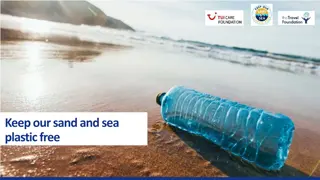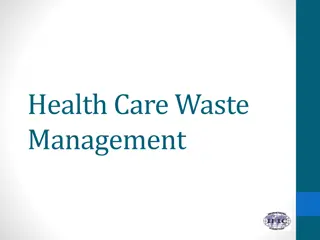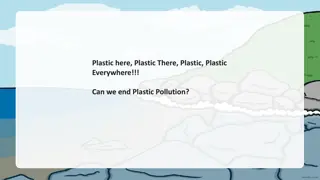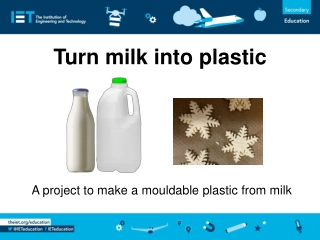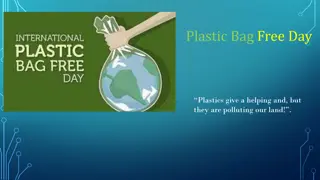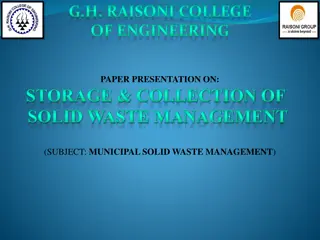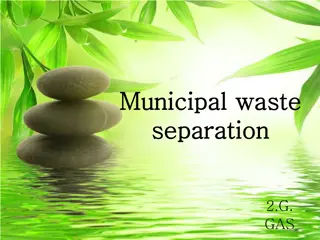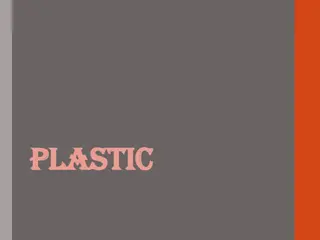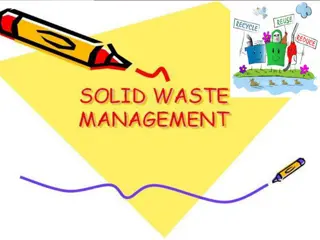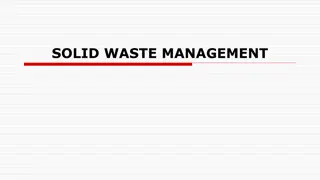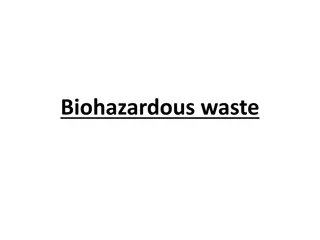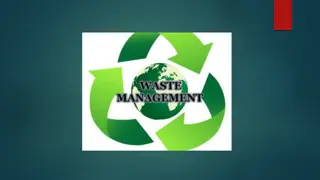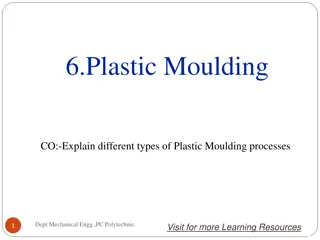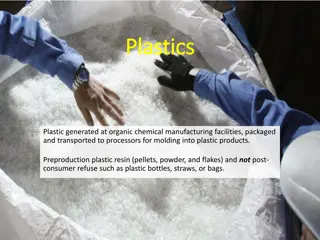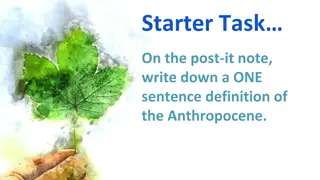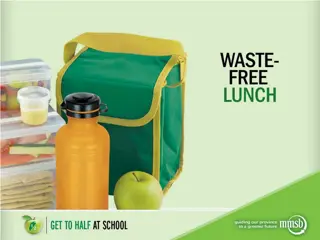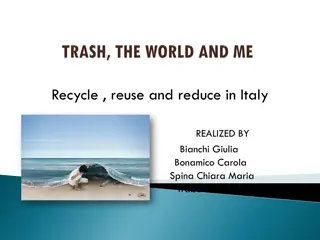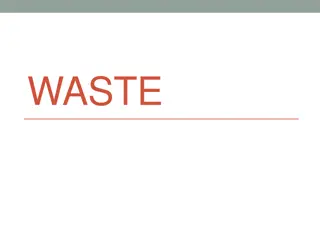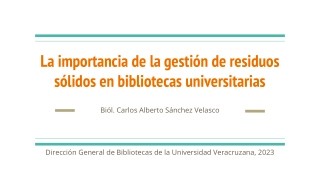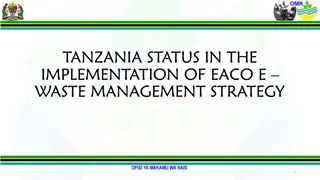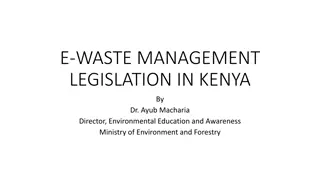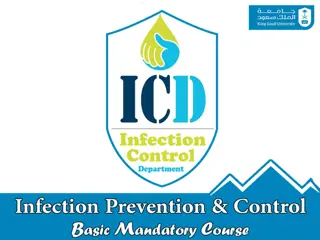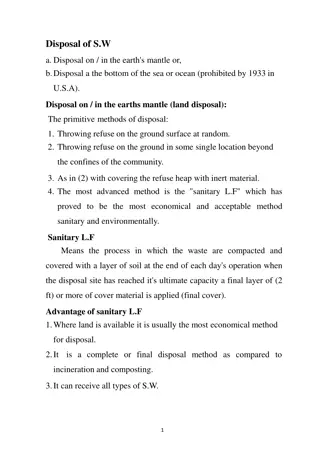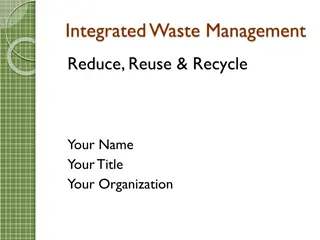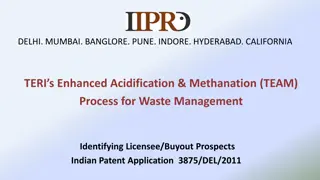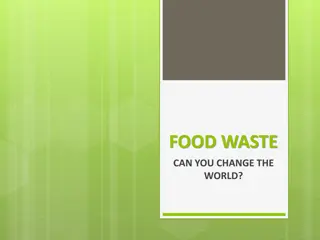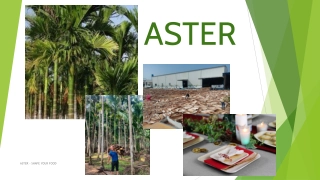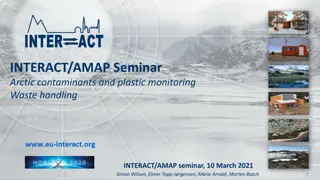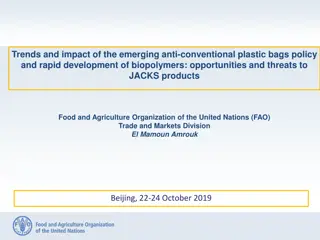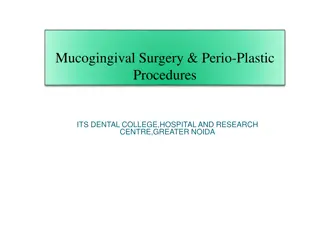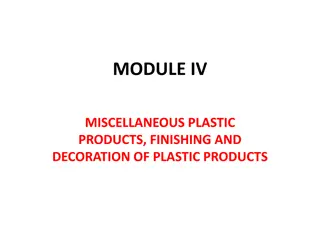The Impact of Plastic Waste on the Environment
Plastic waste, particularly disposable plastic, poses a significant threat to the environment due to its non-decomposable nature. Improper disposal of plastic items leads to littering, pollution, and the formation of harmful microplastics. It is crucial to address this issue through a combination of reducing, reusing, and recycling plastic products. Sanitation practices often conflict with conservation efforts, highlighting the need for sustainable solutions. Effective waste management is essential to mitigate the adverse effects of plastic pollution as the global population continues to grow.
Download Presentation

Please find below an Image/Link to download the presentation.
The content on the website is provided AS IS for your information and personal use only. It may not be sold, licensed, or shared on other websites without obtaining consent from the author. Download presentation by click this link. If you encounter any issues during the download, it is possible that the publisher has removed the file from their server.
E N D
Presentation Transcript
Throwing things away When we throw things away, where is away? In the past, people have thrown waste into rivers and the ocean thinking it would just go away . It doesn t. We ran into serious pollution problems. Environmental laws have slowed these practices, but not completely stopped them. Pollution is a bigger problem as the population grows. As world population continues to rise, will we have enough space for landfills and still have enough livable land?
Littering Disposable plastic is largely to blame for littering problem. Prior to disposable plastic, there wasn t much material for someone to litter with. Even if you did leave materials out, like a newspaper, it would decompose shortly. Plastic on the other hand doesn t decompose. In the 1950 s, several manufacturers formed Keep America Beautiful, which started an ad campaign blaming the litter bug . This shifted the view of the problem to poor behavior of the consumer rather than the industry making all the garbage.
Plastic doesnt decompose Most substances have a natural decomposition method to break it down. Plastics don t. It can take 20-500 years for plastics to break down. Simply burying them in a landfill doesn t make them go away. They just break into smaller pieces called microplastics. Microplastics are being found everywhere (in living things, the ocean, everywhere)
What to do? The rallying cry of environmentalists has been reduce reuse recycle for quite a while. It is important to note that this is in order of usefulness Many people think they are doing all they can by separating materials for recycling. Reduce your usage of something that you don t need to use is much better. It eliminates the waste entirely. Reusing materials allows you to reduce your overall waste.
Sanitation Sanitation and conservationalism will always run against one another. In the past, glass bottle recycling was really reusing. Milk bottles would be returned to be washed and refilled, the same with other bottle types. Single use disposable materials will always be more sanitary than items being washed and reused. This goes for water bottles, grocery bags, everything.
Straws Straws became a recent item that was pointed out as unnecessary. Most people don t use a straw if they are not in a restaurant. It would be quite easy to reduce our usage. And just like that, everyone starting hating straws Plastic straws are rarely recycled and can end up floating in the ocean.
The Ocean If laws prevent people from throwing trash into waterways, why does it still end up there? Light plastic materials are especially hard to keep out of waterways. They float on water. When a storm comes, it is easy to wash the plastic material into the waterways and eventually out into the ocean, even if it was in a landfill. Some people still do dump waste into waterways.
Plastic waste Plastic waste has been sold to countries To more correctly state that, a fee was paid for poorer countries to take our plastic waste. China stopped taking imported plastics It was sold to India and other countries. Much of this plastic ends up in the ocean.
Garbage patches in the ocean In the ocean, there currents (like rivers going though the ocean. The currents lead to swirling areas called gyres. Most of the floating plastic in the ocean ends up at one of these areas as the ocean current eventually push it there. At the 6 gyres in the ocean, there are large collections of plastic waste. In these areas, the plastic doesn t break down. It only breaks into smaller pieces over time. This means there ends up being lots of microplastics.
Great Pacific Garbage Patch This garbage patch spans across two gyres in the pacific ocean. It is far enough away from any coastline that no country is claiming responsibility or attempting to clean it up. It is twice the size of Texas Cleaning it will be a big job! Even if it was clean, you would have to do something to stop it from reforming.
Plastic Recycling A small percentage of plastic that is made is actually recycled. It is cheaper to make new plastic than it is to recycle the old plastic materials and then reuse those materials. A big part of the problem is that there are so many different types of plastics and different additives are added in to give the plastic a specific color or texture or some other property.
Plastic resin codes Plastic is made from raw materials called resin. The materials are stamped with a number to indicate what it primarily is.
This is not enough There are 1000 s of different types of plastic and only 7 numbers. In most cases, there is plastic that is considered recyclable and other that is not. That is because a plant is set up to take one type of plastic and you can t mix them when trying to recycle them. In many cases, plastic bottles with a neck stamped 1 or 2 are recycled other plastic materials are not. This is because plastic bottles are blow-molded where a plastic tub in injection molded
Closing the loop Plastic recycling doesn t create an infinite loop like it does with glass or aluminum. When a plastic bottle is recycled, the plastic degrades so it can t be used to make a new bottle. Instead it has to be used in a lower grade plastic, like jacket fill, carpeting, or plastic lumber. These materials are generally considered not to be recyclable. So we can only recycle that plastic material once.
Republic Services There are many restrictions for recycling https://www.republicservices.com/residents/recycling They want all materials rinsed out, they don t want it bagged. When they are not followed much of the recyclable plastic gets thrown away. In many cases, people/businesses/municipalities decide it is cheaper to throw it away than to attempt to recycle, and they bury it in a landfill


